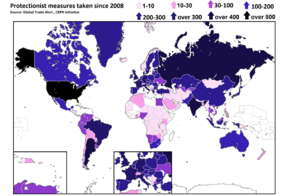Protectionism facts for kids
Protectionism is when a country creates rules to help its own businesses sell more products. It does this by making goods from other countries more expensive or harder to buy. The main goal of protectionism is to reduce imports. Imports are products that a country buys from other countries.
For example, imagine farmers in one country can sell wheat for less money than farmers in another country. If there were no rules, people would buy the cheaper wheat. This would mean the local farmers might not earn enough money. Protectionism tries to prevent this.
Contents
What is Protectionism?
Protectionism aims to protect local industries and jobs. People who support it believe it helps their country's economy grow. They think it keeps money inside the country.
However, protectionism can also make things more expensive for people. If you can't buy cheaper goods from other countries, you might have to pay more for local products. This means some people benefit, while others might pay more.
How Countries Use Tariffs
One common way to use protectionism is through tariffs. A tariff is a special tax added to goods bought from other countries. When a country adds a tariff, it makes imported goods more expensive. This encourages people to buy local products instead.
Governments can also earn a lot of money from these tariffs. People who believe in protectionism often support high tariffs.
Understanding Trade Wars
Sometimes, when one country raises its tariffs on another, the second country might do the same. This is like a game of "getting even." When countries keep raising tariffs against each other, it's called a trade war.
A famous example happened in the United States. In 1930, the US passed a law called the Hawley-Smoot Tariff. This law made tariffs on European goods very high. In return, European countries raised their tariffs on US goods. This started a big trade war. Many experts believe this trade war made the Great Depression much worse.
Protectionism vs. Free Trade
Today, protectionism is not as popular as it used to be. Most countries now support free trade. Free trade is the opposite of protectionism. It means governments try to make it easier for countries to trade with each other.
With free trade, there are fewer tariffs and rules. This allows goods to move freely between countries. Supporters of free trade believe it leads to lower prices for consumers and more choices. It can also help different countries work together better.
Images for kids
-
Political poster from the British Liberal Party displaying their views on the differences between an economy based on free trade and protectionism. The free-trade shop is shown as full to the brim with customers due to its low prices. The shop based upon protectionism is shown as suffering from high prices and a lack of customers, with animosity between the business owner and the regulator.
See also
 In Spanish: Proteccionismo para niños
In Spanish: Proteccionismo para niños








